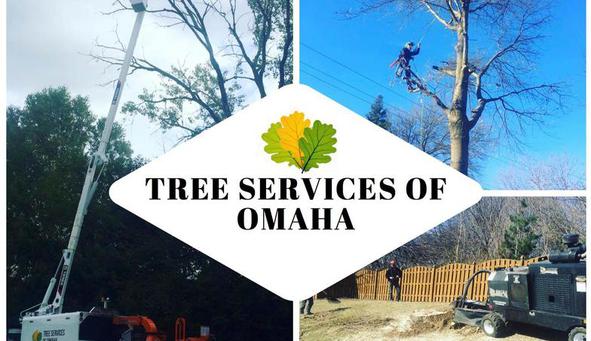Tree Services of Omaha - Omaha, Nebraska
Arborist Tree Felling Techniques
by David Steg on 10/16/14
Trees are the largest living things on the planet. However, even a small tree can pose some risk to person and property, especially during a tree removal operation. We believe that our knowledge of trees and plants as biological structures makes us better equipped to safely remove trees. Following are the most common tree removal methods, listed from simplest to most complex.
TREE FELLING
 Tree falling, or felling, is the process of cutting a tree at the base, and letting the whole tree fall to the ground. It is often the easiest and most inexpensive way to remove a tree. Felling can also be the safest method of tree removal, yet there is potential for catastrophic damage if not done properly. How the felling notch is formed, manner in which the back cut is made, and methods for overcoming back and side lean are all major factors determining the success of a tree felling procedure. While this procedure might be the quickest way to get a tree on the ground, it often requires the greatest amount of clean up on site. The ground may be depressed and branches quite often are impaled straight into the ground.
Tree falling, or felling, is the process of cutting a tree at the base, and letting the whole tree fall to the ground. It is often the easiest and most inexpensive way to remove a tree. Felling can also be the safest method of tree removal, yet there is potential for catastrophic damage if not done properly. How the felling notch is formed, manner in which the back cut is made, and methods for overcoming back and side lean are all major factors determining the success of a tree felling procedure. While this procedure might be the quickest way to get a tree on the ground, it often requires the greatest amount of clean up on site. The ground may be depressed and branches quite often are impaled straight into the ground.
TRADITIONAL TREE REMOVAL
The most frequently performed tree removal technique in our Seattle area involves an arborist removing all of the branches on a tree as he encounters them on the ascent up the trunk of a tree. When the arborist reaches the top of the tree, a felling cut is made and the upper portion of the trunk falls to the ground. The arborist then begins to cut and push sections of wood from the trunk, letting them free fall to the ground below. The arborist usually stops when the remaining trunk is short enough to be safely felled. This tree removal procedure is sometimes referred to as “cut and chuck.” While often quickly performed, there are limitations to this method due to safety and potential for damage to the ground below.
SPAR POLE RIGGING
Spar pole rigging is different from the traditional tree removal technique, in that after the branches have been trimmed from the trunk, the top and subsequent pieces of wood are caught by a rigging rope and lowered to the ground by an arborist. Once the determination is made to rig pieces out of a tree, factors of safety become critical in this tree care operation. The weight of wood and the structural strength of the rigging point are two of the factors considered by the arborist team.
WHOLE TREE RIGGING AND REMOVAL
For zero impact tree removal, every part of the tree must be attached to a rope, and lowered from an overhead rigging point. A professional arborist will use many techniques, such as slide lining/speed lining, lifting and lowering, floating anchor points, balancing branches so they float horizontally, and a combination of any of these methods. A crane is often utilized to remove a tree when the tree is deemed unsafe for an arborist to climb it.






